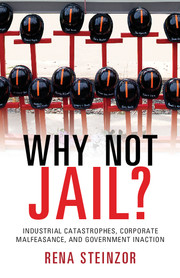Introduction
Published online by Cambridge University Press: 05 December 2014
Summary
On April 5, 2010, an enormous explosion tore through Massey Energy’s Upper Big Branch mine in Montcoal, West Virginia, propelling flames at a speed of one thousand feet per second in all directions from the point of ignition as far as two miles underground. Twenty-nine men were killed instantly in the worst mine disaster in four decades. Numerous blatant and well-known violations of mine safety laws caused the explosion, from the chronic buildup of highly combustible methane to the malfunctioning equipment that produced the igniting spark. In the weeks leading up to the accident, Mine Safety and Health Administration (MSHA) officials had ordered the evacuation of Upper Big Branch on three separate occasions because excessive methane made the mine too dangerous to work. Despite these efforts to nudge Massey back into line with safety requirements, 13,000 citations for illegal conduct throughout the industry were pending before MSHA at the time, including several hundred involving the Upper Big Branch mine, because the agency was paralyzed by its own dysfunctional system for enforcing these requirements.
To his great credit, Booth Goodwin, West Virginia’s top federal prosecutor, filed criminal charges against four Massey employees, including three relatively low-level supervisors and the senior manager of the subsidiary responsible for the Upper Big Branch mine. The senior manager, David C. Hughart, is cooperating with Goodwin, and hopeful rumors circulate in neighboring communities that Don Blankenship, Massey’s notorious chief executive officer, is the ultimate target of the investigation. If Blankenship is indicted and either pleads guilty or is tried, the case will be the first in decades to travel up the chain of command to the person who was ultimately responsible for the catastrophe.
- Type
- Chapter
- Information
- Why Not Jail?Industrial Catastrophes, Corporate Malfeasance, and Government Inaction, pp. 1 - 10Publisher: Cambridge University PressPrint publication year: 2014



